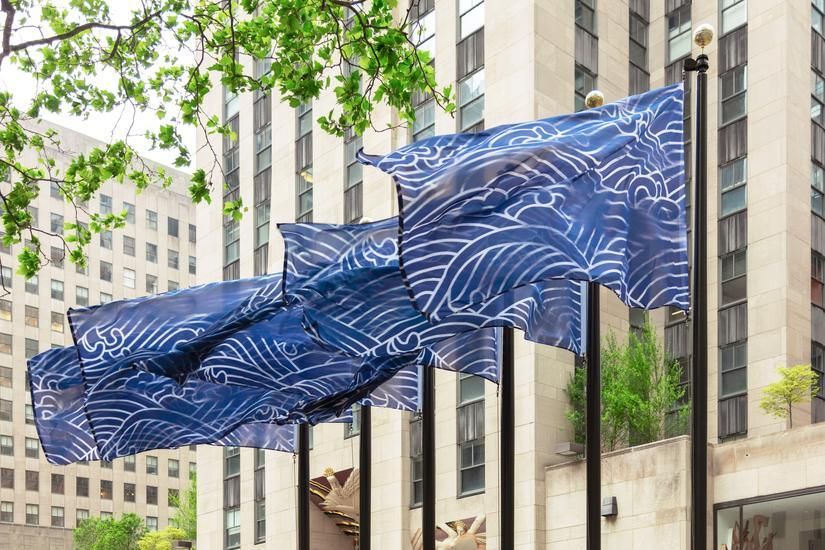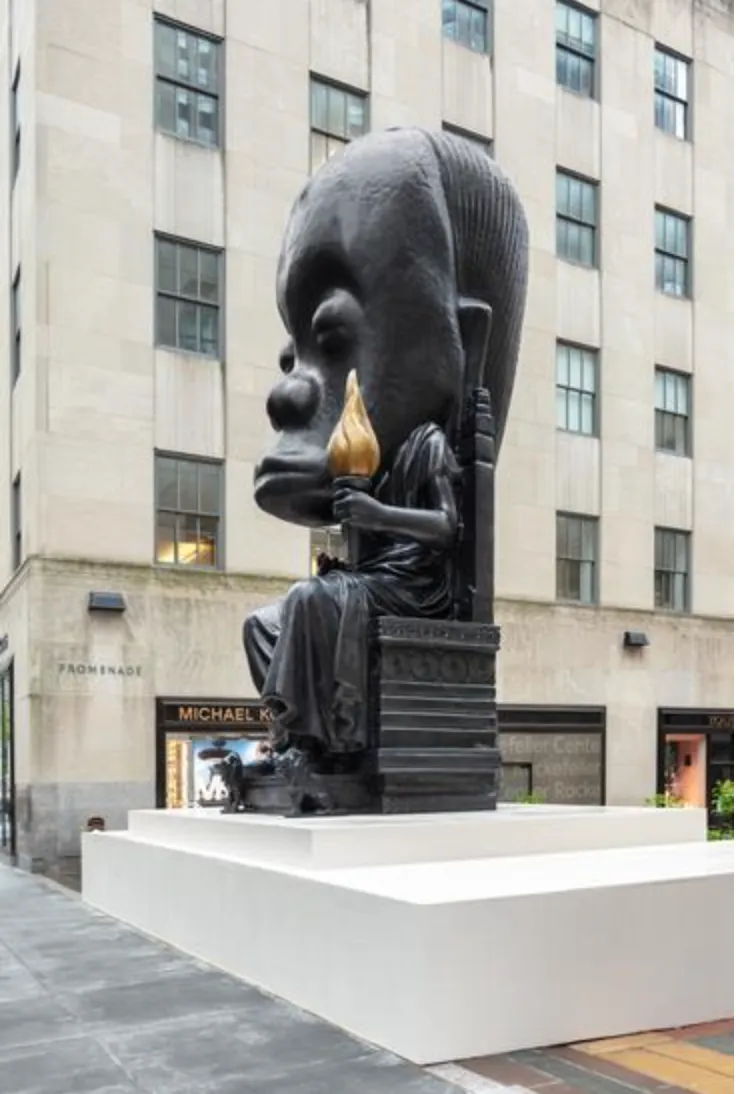This Monumental ‘Oracle’ Statue in NYC Subverts Traditional Sculpture
Part of an ongoing exhibition at Rockefeller Center, Sanford Biggers’ newest installation challenges the tropes of classical artwork
/https://tf-cmsv2-smithsonianmag-media.s3.amazonaws.com/filer/5f/e4/5fe4a01b-fece-44c6-855f-f384ec7456f0/oracle.jpeg)
References to classical mythology abound in and around Rockefeller Center. An iconic Art Deco complex in New York City, the space boasts a gilded bronze sculpture of the Titan Prometheus, a 1930s relief of a fearsome Zeus that adorns the 30 Rockefeller Plaza entrance and a statue of an overburdened Atlas that looms over Fifth Avenue.
Through June 29, members of the public can visit (and eventually interact with) another monumental addition to the Manhattan landmark: artist Sanford Biggers’ Oracle, a 25-foot-tall, 15,280-pound bronze sculpture. Unveiled last week, the work depicts a person or deity with an enormous head who sits majestically on a throne in front of Rockefeller Center’s Fifth Avenue entrance.
Oracle is the latest entry in Biggers’ Chimera series, which merges European statues and African masks in an interrogation of sculptural art’s history and power, reports Sarah Cascone for Artnet News. The work is Biggers’ largest-scale Chimera commission to date, notes a statement from exhibition co-organizer Art Production Fund.
As Biggers tells Artnet News, he drew inspiration from the ancient Greek Temple of Zeus and African religious art, especially that of the Luba and Maasai cultures. Per the statement, the artist was also intrigued by ongoing scholarly conversations about the whitewashing of European sculptural history and “black-washing” of African sculpture. (In a separate statement from the Marianne Boesky Gallery, Biggers points out that Westerners stripped “hundreds of [African] objects … of all material adornment and any ritual and cultural residue” during the early 20th century.)
“The entire installation is based on mythology, narrative and mystery,” Biggers tells the Art Newspaper’s Gabriella Angeleti. “Rockefeller Center itself, as an architectural entity, is very much steeped in mythology and mystery.”
In the coming weeks, reports Artnet News, visitors will be able to activate a QR code near the sculpture and literally ask the “oracle” figure a question. They may then receive an answer from one of several unnamed celebrities, who will take turns answering queries with “mysterious, poetic vagaries,” Biggers adds.
Biggers’ Rockefeller Center takeover also features flags, photographs, music, other Chimera sculptures and video works installed inside and outside of the complex. The show marks the New York City landmark’s first-ever campus-wide exhibition designed by a single artist, according to Reuters. It was originally scheduled to debut in September 2020 but was delayed until May 5 due to the Covid-19 pandemic, per Artnet News.
Born in Los Angeles, Biggers has lived and worked in New York City since 1999. In “Codeswitch,” a recent show at the Bronx Museum, the artist displayed 50 paintings and sculptures that he constructed out of vintage African American quilts.
As Siddhartha Mitter reported for the New York Times last year, Biggers drew inspiration for this series from the quilters of Gee’s Bend, a rural Alabaman community of mostly women quilters who have been sewing abstract, masterful works of art since the early 19th century.
The Sanford Biggers exhibition is now live! With a 15,280 pound sculpture, murals, paintings and elaborate quilts— it is the largest compilation of art by a single artist ever displayed on our campus.
— Rockefeller Center (@rockcenternyc) May 5, 2021
It will be on view until June 29. https://t.co/qkcW6aEW2b pic.twitter.com/ssTZDSThy6
The quilts contain “color, modulation, rhythm and all these compositional things,” Biggers told the Times in 2020. “But seeing them in these beautiful textile works made by a woman’s hands, it was touching on sculpture, touching on the body, touching on politics.”
Outside of these works, Biggers is known for his “sculpture-by-gunfire,” the Times notes. For his BAM series, he reshaped wax-dipped bronze sculptures by shooting them with bullets at a firing range. The interdisciplinary artist also sings and plays the keys in Moon Medicin, an experimental funk group. (His band even curated a soundtrack—available on Spotify—for the Rockefeller installation.)
At Rockefeller Center, Biggers’ quilted works appear alongside blue flags decorated with white, wave-like patterns. The flags’ design evokes Japanese kimonos and Buddhist mandalas, as well as the waves of the Middle Passage, the forced voyage of enslaved Africans across the Atlantic Ocean to the Americas.
Speaking with Artnet News, Biggers points out that references to the Atlantic Slave Trade appear throughout the Rockefeller complex’s intricate Art Deco designs, which were crafted in the mid-20th century.
“You see references to tobacco and cotton and sugar,” Biggers says. “I wanted to put a piece here that … is actually looking past that at the magnificent and powerful influence that African diasporic culture has had on New York City throughout its history.”
/https://tf-cmsv2-smithsonianmag-media.s3.amazonaws.com/accounts/headshot/nora.png)


/https://tf-cmsv2-smithsonianmag-media.s3.amazonaws.com/accounts/headshot/nora.png)